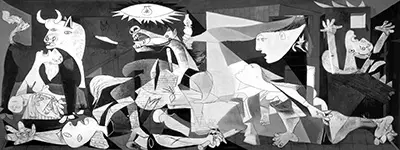Guernica is a powerful, political painting by Picasso as a protest against war.
The painting captures the destruction of a village in Northern Spain as part of the Spanish Civil War.
Political Meaning behind Guernica
Picasso produced the painting shortly after the attack, which was led by German and Italian warplanes whose respective governments were supporting the Fascist regime in Spain.
The artist's views were expressed in this piece about a specific air campaign which he was very concerned about, but this painting has since become a symbol of anti-war campaigning more generally.
Picasso, like many others, viewed the attack as both unecessary and also indescriminant. Perhaps even evil. Art and music have long been used as a demonstration tool for all manner of political campaigns, with anti-war being one of the most common.
The symbolic use of Bulls and Horses in this painting are not easy to intepret. The artist used them continuously throughout his career, and would attach different meanings to them under different contexts. As such, it is difficult to be confident on his reasons for using them here.
Historical Ownership and Location of the Painting
The Museo Reina Sofia in Madrid, Spain holds this important painting although it also was held at MOMA in the United States for several years. It's politial statement made it impossible to display in Spain during the reign of Fascism there.
Picasso sensibly ruled that this painting should never appear in Spain before liberty had been restored as he knew it would be destroyed or confiscated whilst the existing ruling powers remained.
Picasso toured the completed Guernica around the worldin order to bring the Spanish Civil War to the world's attention. It was one thing to create this masterpiece, but it's impact would only be maximised by effective promotional activities.
Stages of Development of Guernica
Early Preparatory Drawings
Picasso's Guernica was not just one single painting on its own, but a large scale project that included hundreds of study artworks in order to ensure that the final mural was the best that it could be.
He saw these study sketches as a souvenir of the way in which the Guernica artwork metomorphosised into the final painting.
Picasso would practice precise details of the work in pencil or chalk before adding them into the production piece.
Typically, he would select characters individually for artistic focus.
Artist Picasso also felt that by concentrating on individual sections he could avoid a common scenario where large artworks move away from the original idea and it can be hard to reverse this momentum.
Picasso's first preparatory drawing was entitled Composition study, Pencil on blue paper. It was dated May 1, 1937.
It is a loose drawing without detail. It outlines his initial ideas for the general layout, featuring an upright bull, a light bearer, a distraught victim plus a layer of bodies strewn below.
Such brisk pencil strikes enabled him to make several more study pieces in that same day.
The third artwork that day would begin to reveal his ideas around swirling, intertwined creatures which would become such a significant feature of the completed mural.
The sixth artwork of the day would bring greater clarity to the bull and horse and would draw to a close this productive day. It was completed as a pencil on gesso on wood .
The following day he would seek to refine the detail on the horse's head. After two experimental drawings he would produce an oil on canvas that focused purely on the horse.
Later that day he would revisit the overall composition of Guernica with a further pencil and gouache on gesso on wood drawing.
It would then be around a week later before his next addition in this series would appear. May the 8th brought about a clear outline for the finished work, at least from a raw, unpolished angle.
Satisfied with this, Pablo Picasso would then spend the rest of the day focusing on the mother with a dead child. This is clearly a symbolic component for portraying the genocidal attack plus the destruction left afterwards.
Pablo would spend the next few days continuing to expand upon specfic details as well as adding more detail to his composition pieces.
The horse's head would continue to draw the most focus at this point in the painting's development.
Pablo would spend the next few days continuing to expand upon specfic details as well as adding more detail to his composition pieces.
The horse's head would continue to draw the most focus at this point in the painting's development.
Buying your own Guernica Art Print Reproduction
Guernica Picasso prints are some of the most popular reproductions from the career of Pablo Picasso, and you can see Guernica below where it is available to buy now from the links above and below the picture.
This particular painting is also one of the finest works from famous Spanish artist Picasso who specialised in several different art movements, including cubism and other contemporary art movements.
This painting is available to buy as an art print from Art.com, who are our recommended retailer who we have actually used regularly ourselves. Art.com sell Guernica framed and unframed art prints, posters and stretched canvases as well as many other works from his illustrious career.
Picasso's career took in a wealth of different mediums and movements, including painting, ceramics plus traditional and modern art which ensures his work can appeal to so many different art enthusiasts.
Guernica is personally one of our favourite Picasso prints of all those that you might consider adding to your wall at home.

